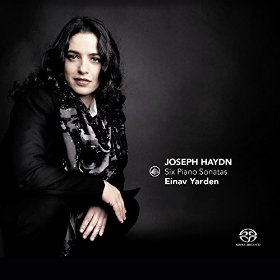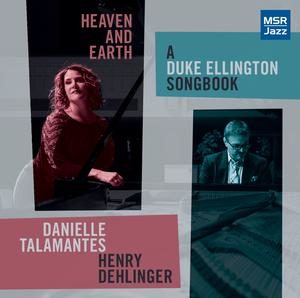Serendipity counts in music as in anything else. A year and a half ago I recommended two outstanding debut albums by artists with local connections. Soprano Danielle Talamantes, a Northern Virginia native with a burgeoning opera career, and pianist Einav Yarden, a protégé of the Peabody Institute’s Leon Fleischer with an international concert career, had found seams in the recorded literature and made their mark with fascinating concepts and performances.
Last month they did it again, each releasing their sophomore albums within 11 days of each other – Einav with a doubling down on her talent for witticisms from the classical piano masters, and Danielle with a bold crossover move into the jazz arena. Earlier this year, one of the region’s more established and popular classical music presences, Baltimore Symphony Orchestra oboist Katherine Needleman, also issued a new CD with a wealth of discovery for listeners. Taken together, these three favorite new recordings from artists with local connections represent a diverse bounty for 2016. Enjoy!
Oboist Katherine Needleman with Pianist Jennifer Lim, ‘Duos for Oboe and Piano’
Put an evocative melody into an expressively played oboe line, and you’re liable to hum it for the rest of the day or night. You also might be more willing to follow that distinctive sound into more challenging arenas of music.
That’s what oboist Katherine Needleman achieves in Duos for Oboe and Piano with pianist Jennifer Lim. A gorgeous opening set of three Romances written in 1849 by Robert Schumann leads into three additional multi-movement works, all of them presenting distinct intellectual challenges for the listener. Different listeners will grab onto different selections here, but that figures for such a versatile musician as Katherine, who has a devoted following among regular concert-goers to the Baltimore Symphony Orchestra, where she has been principal oboe for more than a decade.
For me, Katherine’s performance of the 1962 oboe sonata by French composer Francis Poulenc really hits home. An almost Sondheim-ish opening of the second movement, which sounds like an ironically rushing New York scene right out of the musical Company, continues off on a tangent of almost entirely dissonant high oboe notes. From there it’s a ping-pong match between the oboe and piano before the original theme returns in a compact but very active movement.
Poulenc’s first movement is an elegy in which Katherine plays almost jazzy intervals against a slowly pulsating piano line, using a beautiful tone development that lingers in the air before appearing to shed a tear at the end of certain notes. The third movement is a more explicit lament played against broader, more dramatic chords in the piano. This movement was the last thing Poulenc ever wrote, evaporating into silence at the end. Low and dark tones in the oboe halfway through the movement set up Katherine’s ability to fade out longer, higher notes in that special way where sound and silence seem to bleed into one another.
The disk is also an introduction to the music of Pavel Haas, a Czech composer who was caught up in one of the most surreal episodes of the Holocaust. Like tens of thousands of other Czech Jews, Haas was rounded up and sent to a sort of Potemkin village of a concentration camp in the Czech village of Terezin, where the prisoners actually continued their regular occupations, such as composing and performing music, for a Nazi propaganda effort before being transported elsewhere for death. Haas himself was murdered at Auschwitz in 1944.
Haas’ suite for oboe and piano was written in 1939 before these events, but it’s contemporary with the Nazi conquests of Polish and Czech lands. That’s not hard to hear in the force and anger of this music, but the suite is structured to leave off at the end with a touch of patriotism and hope in the Czech hymn to St. Wenceslas. There’s a bit of an extra pungency and bite to Katherine’s oboe lines that wander in, out and around a busy piano part. The disk also includes a very contemporary work – seven brief Microludes written in 2005 by American composer David Ludwig – for which listener reaction is bound to be very individual.
Special note has to be made of the dynamic range of Jennifer Lim’s piano playing throughout this album. Ms. Lim’s very quietest notes have a remarkable presence and touch in the special acoustic of the recording location – the Mendelssohn Hall at the Gewandhaus in Leipzig, Germany, home to one of the world’s leading orchestras. It’s quite an experience to listen to.
Pianist Einav Yarden, ‘Haydn: Six Piano Sonatas’
Nobody does “funny” on the piano like Einav Yarden. Okay, she gets a lot of help from Joseph Haydn, the classical master who was a mentor to Mozart and teacher of Beethoven. But like jokes in a written script, it’s all in the delivery and timing.
Haydn’s wit is best known from his later symphonies with nicknames like “The Bear,” “The Hen,” “The Clock,” and “The Surprise.” His lesser-known piano sonatas, especially from his middle period in the 1770s, are more of a revelation. That’s what Einav brings here, with Six Piano Sonatas that are varied gems of inspiration and inventiveness. Her tools are hills and valleys of dynamics, extra little split-seconds of rests followed by cascading notes, and a robust bass line that matches left-hand articulation to the right-hand filigrees.
The first movement of the D major sonata (the numbering systems for Haydn’s compositions are the funkiest in the business, so I’ll stick with the keys instead) starts as a happy-go-lucky romp in a sunny key. Its second theme turns into a mock-serious minor theme in alternating hands, with both starting on the exact same piano key and then fanning out in opposite directions. The piece then moves into a quite substantial development section bordering on the virtuoso and dramatic, before handing off to the recapitulation where everything is joyfully reviewed back in solidly optimistic D major.
Listen to Einav’s interpretation with the image of several balls bouncing down a hill or a decorative water fountain doing choreography, and the sense of playfulness and controlled acceleration will come to life beyond the abstraction of instrumental music. As a sneaky little trick, then call up a YouTube video of one of the 20th century’s greatest pianists, Sviatoslav Richter, playing the same piece and tell me you are not comparatively bored to tears.
Not everything in Haydn’s music is fun and games, nor would it be given his talent for originality across his enormous output of music. The most expansive movement on Einav’s disk is the first movement of the A major sonata, which mixes Mozartean lyricism with manipulation and modulation of themes across a comparatively broad canvas. Einav (whose first name I’ve even heard concert promoters pronounce wrong – say the letter “A” and then “knob” with a “v” on the end instead and you got it) gives this first movement substantial space to unfold with a more moderate tempo.
The A major sonata continues with a minuet whose bounciness she almost exaggerates with ultra-staccato left-hand notes, and then rounds out with a headlong, 51-second presto that gives the impression of hurtling downhill its entire length. By raising the dynamics to very loud on the downslope, especially at the end, Einav makes it very akin to broad comedy.
But beyond the jokey material, classical connoisseurs will also appreciate the theme and variations that make up the last movement of the E major sonata – clearly an inspiration for Beethoven in his large output of piano variations, including within several of his sonatas – and several Baroque touches in Haydn’s searching B minor sonata that closes out the disk.
Soprano Danielle Talamantes with Pianist Henry Dehlinger, ‘Heaven and Earth: A Duke Ellington Songbook’
Danielle Talamantes doesn’t see why an opera singer shouldn’t sing Duke Ellington, and I bet Duke Ellington wouldn’t either. He considered himself simply an American composer who was secure enough to design his writing for the skills of his musicians, and who let many of his compositions acquire their now-iconic lyrics years after the music was set down.
For Danielle, who now sings lead soprano roles in several regional opera companies around the U.S. and supporting roles at the Metropolitan Opera, the achievement of placing her sophomore album on the MSR Jazz label is significant. For the listener, the new interpretive experience of hearing these “jazz standards” is distinctive, and not necessarily in the ways you might expect.
At the risk of stating a technicality of the physics of sound, Danielle’s note placement is exemplary, and creates magnificent overtones in the acoustic of Vienna Presbyterian Church, where Heaven and Earth was recorded. Jazz singers are great at “blue notes” but may sing the main verses and melodies in a pedestrian, piano-imitative way. By contrast, Danielle’s leading tones cozy right up to their target notes all across the spectrum, with just the right amount of time-spacing to grab your ears and not let go.
A chromatic opening to “Prelude to a Kiss,” leading all the way to a high, beautifully meandering vocal ending with every note a new surprise, highlights this concept. Less than a minute and a half into the album, with “Come Sunday,” Danielle situates the start of the last syllable of the phrase “God above” right above where it really belongs, drops down to sing the target note – and then changes her mind, returning to the higher pitch and lingering there for a delicious extra second before going back down to the right note. It’s a shimmering effect.
In extensive liner notes, Danielle’s commentator Scott Parrish is at pains for you to know where this classically trained soprano uses a restrained rather than full vibrato. But Danielle has many variations on this theme. In one approach she leaps to a high note and begins it with a bit of graininess, then pulls the note together into a straight tone and teases you before widening into her vibrato. Listen to her sing “In a Sentimental Mood” early in the CD and you’ll recognize the effect several times later on.
Certainly some listeners may miss other facets of jazz singing that they’re used to. The songs are pitched higher than their classic recordings with singers such as Mahalia Jackson and Ella Fitzgerald, or Tony Bennett for that matter, and Danielle typically substitutes prettiness for smokiness in her lower tones. A slightly less rhetorical approach than other interpreters gives her a more Latinate “ah” sound and sometimes a special, wider take on ordinarily hard or swallowed American English vowels in words like “Gershwin” and “eternity.”
But the CD is also a stage for originality in arrangement and collaborative piano work. Danielle’s pianist, Henry Dehlinger, arranged half of the tracks on the CD, and his piano work is often delightfully cliché-free, with his “Sophisticated Lady” particularly notable. Danielle also called on other innovative new arrangers, and Caren Levine delivers big-time on “In My Solitude.” If you want to hear a fusion of jazz with contemporary “serious music” modalities, listen to Mr. Dehlinger play Ms. Levine’s twisting and climbing chords and snaking counter-lines while Danielle sings long, languid notes, and prepare to be mesmerized. Then enjoy Mr. Dehlinger’s substantial piano cadenza before Danielle returns for a virtuoso vocal conclusion.
Danielle closes with three of Ellington’s lesser-known religiously themed works from his 1968 Second Sacred Concert at New York’s Cathedral of St. John the Divine. With the civil rights-inflected positive spirituality of “Come Sunday” having opened Danielle’s disk, these selections provide an apt finish to a truly innovative recording.
Running Times: Duos for Oboe and Piano, 64:53. Haydn: Six Piano Sonatas, 62:20. Heaven and Earth: A Duke Ellington Songbook, 50:47.
For more information on their upcoming live events, please see the websites for Katherine Needleman, Einav Yarden, and Danielle Talamantes.
LINK:
Standout CDs of Three Rising Classical Artists: Einav Yarden, Yevgeny Kutik, and Danielle Talamantes by David Rohde.







